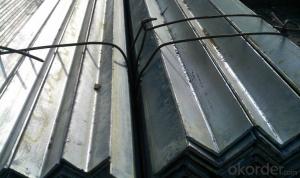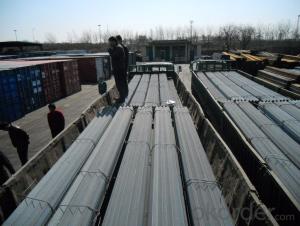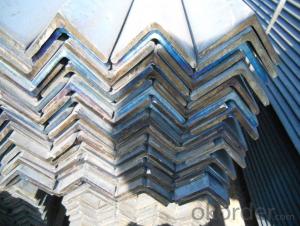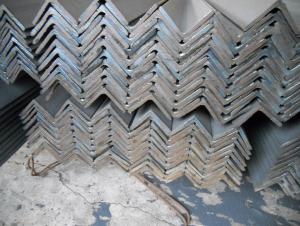GB Equal Structural Angle Steel
- Loading Port:
- Tianjin
- Payment Terms:
- TT OR LC
- Min Order Qty:
- 1000 m.t.
- Supply Capability:
- 30000 m.t./month
OKorder Service Pledge
OKorder Financial Service
You Might Also Like
Product Description:
Specifications of GB Equal Structural Angle
1. Invoicing on theoretical weight or actual weight as customer request
2. Length: 6m, 9m, 12m
3. Material:Material: GB Q235B, Q345B or Equivalent; ASTM A36; EN 10025, S235JR, S355JR; JIS G3192, SS400;
SS540.
4.Sizes:
Sizes: 25mm-250mm | ||
a*t | ||
25*2.5-4.0 | 70*6.0-9.0 | 130*9.0-15 |
30*2.5-6.6 | 75*6.0-9.0 | 140*10-14 |
36*3.0-5.0 | 80*5.0-10 | 150*10-20 |
38*2.3-6.0 | 90*7.0-10 | 160*10-16 |
40*3.0-5.0 | 100*6.0-12 | 175*12-15 |
45*4.0-6.0 | 110*8.0-10 | 180*12-18 |
50*4.0-6.0 | 120*6.0-15 | 200*14-25 |
60*4.0-8.0 | 125*8.0-14 | 250*25 |
5. Material details:
Alloy No | Grade | Element (%) | |||||
C | Mn | S | P | Si | |||
Q235 | B | 0.12—0.20 | 0.3—0.7 | ≤0.045 | ≤0.045 | ≤0.3 | |
Alloy No | Grade | Yielding strength point( Mpa) | |||||
Thickness (mm) | |||||||
≤16 | >16--40 | >40--60 | >60--100 | ||||
≥ | |||||||
Q235 | B | 235 | 225 | 215 | 205 | ||
Alloy No | Grade | Tensile strength (Mpa) | Elongation after fracture (%) | ||||
Thickness (mm) | |||||||
≤16 | >16--40 | >40--60 | >60--100 | ||||
≥ | |||||||
Q235 | B | 375--500 | 26 | 25 | 24 | 23 | |
Usage & Applications of GB Equal Structural Angle
According to the needs of different structures, Angle can compose to different force support component, and also can be the connections between components. It is widely used in various building structures and engineering structures such as roof beams, bridges, transmission towers, hoisting machinery and transport machinery, ships, industrial furnaces, reaction tower, container frame and warehouse etc.
- Q: How do you determine the deflection of a steel angle?
- To determine the deflection of a steel angle, you need to consider various factors such as the material properties of the steel, the dimensions of the angle, and the applied load. The deflection of a steel angle can be determined using mathematical equations and formulas, specifically those related to structural mechanics. Firstly, you need to determine the moment of inertia (I) of the steel angle, which depends on its cross-sectional shape and dimensions. The moment of inertia represents the resistance of the angle to bending and is a crucial parameter in calculating deflection. The moment of inertia can be obtained from engineering handbooks or calculated using mathematical formulas specific to the shape of the angle. Next, you need to determine the load that is applied to the steel angle. This load can be in the form of a concentrated force, a distributed load, or a combination of both. The magnitude and distribution of the load will influence the deflection of the angle. Once you have determined the moment of inertia and the applied load, you can use the appropriate deflection equation or formula to calculate the deflection of the steel angle. The specific equation used will depend on the type of loading and the boundary conditions of the angle (e.g., whether it is simply supported or fixed at both ends). For example, if the steel angle is subjected to a concentrated load at its midpoint and is simply supported, you can use the equation for deflection of a simply supported beam under a concentrated load. This equation relates the deflection (δ) to the applied load (F), the length of the angle (L), the moment of inertia (I), and other relevant constants. It is important to note that the deflection calculated using these equations is an approximation and does not take into account factors such as material imperfections, fabrication tolerances, or the effects of dynamic loading. Therefore, it is always advisable to consult relevant design codes, standards, or engineering handbooks to ensure accurate and safe design practices when determining the deflection of a steel angle.
- Q: Can steel angles be easily cut to size?
- Certainly! Cutting steel angles to size is a breeze. These angles are widely employed in construction and fabrication endeavors, and they come in a range of lengths and sizes. Achieving the desired length is a simple task with tools like a hacksaw, angle grinder, or plasma cutter. Nevertheless, the ease of cutting steel angles hinges on the steel's thickness and hardness. If the angles are thicker and harder, more potent tools and cutting techniques may be necessary. It's crucial to employ proper safety precautions and tools to guarantee precise and flawless cuts when working with steel angles.
- Q: What are the common surface treatments used for steel angles?
- The common surface treatments used for steel angles include galvanization, powder coating, and painting.
- Q: What are the dimensions of a standard steel angle?
- The dimensions of a standard steel angle typically include the length of the legs and the thickness of the steel.
- Q: What are the common applications of steel angles in the automotive industry?
- Steel angles are commonly used in the automotive industry for various applications such as reinforcing structural components, supporting body panels, creating brackets and mounts, and enhancing overall vehicle safety and stability.
- Q: What is the bending capacity of a steel angle?
- The bending capacity of a steel angle refers to its ability to withstand bending or flexing without breaking or deforming excessively. It is a measure of the angle's structural strength and is typically determined by factors such as the dimensions and thickness of the angle, the type of steel used, and any additional reinforcements or supports present. The bending capacity is usually expressed in terms of the maximum amount of load or stress that the angle can endure before it reaches its yield point, which is the point at which it permanently deforms. The bending capacity of a steel angle can vary widely depending on these factors, and it is crucial to consider this capacity when designing and constructing structures that utilize steel angles to ensure their structural integrity and safety.
- Q: What is the maximum bending moment for a steel angle?
- The maximum bending moment of a steel angle is influenced by various factors, including the angle's dimensions and properties, the load applied, and the support conditions. Typically, the highest stress occurs at the location where the angle is subjected to the maximum bending moment due to the applied load. To determine the maximum bending moment of a steel angle, it is necessary to consider the section modulus (which measures the angle's resistance to bending), the distance between the load and support, and the magnitude and distribution of the load. The section modulus is calculated based on the angle's dimensions, including its thickness, height, and width. Engineers analyze the applied load and support conditions using principles of structural mechanics to ascertain the maximum bending moment of a steel angle. This information is crucial for designing and evaluating the structural integrity of steel angle components in various applications, such as construction, manufacturing, and infrastructure projects. It is important to recognize that the specific dimensions, material properties, and applied load can significantly affect the maximum bending moment. Therefore, it is essential to refer to relevant design codes, standards, or seek guidance from a qualified structural engineer for precise and detailed calculations specific to a particular steel angle.
- Q: What are the different methods of impact testing for steel angles?
- To assess the toughness and resistance of steel angles, engineers and manufacturers have access to various impact testing methods. These include the Charpy V-notch test, the Izod test, and the drop weight test. The Charpy V-notch test is widely utilized and involves placing a notched specimen of the steel angle in a pendulum hammer. Upon release, the hammer swings down and strikes the specimen. The energy absorbed by the specimen before it fractures determines the material's impact toughness. Similarly, in the Izod test, a notched specimen is clamped vertically, and a pendulum hammer strikes it horizontally. The absorbed energy is then measured to evaluate the specimen's impact resistance. Finally, the drop weight test requires dropping a weight onto a supported specimen from a specific height. The impact energy is calculated based on the weight and drop height. The specimen's deformation and fracture behavior are analyzed to determine its impact toughness. These diverse impact testing methods provide engineers and manufacturers with vital insights into the ability of steel angles to endure sudden impacts or shock loads. By assessing the material's toughness and resistance, these tests aid in designing structures and selecting suitable materials for various applications.
- Q: What is the typical lead time for steel angle orders?
- The lead time for steel angle orders can differ due to various factors, including the supplier, quantity, customization needs, and prevailing market conditions. Typically, the lead times for such orders fall within a 2 to 4-week range. This time frame accounts for order processing, steel angle manufacturing or sourcing, and transportation to the desired destination. It is worth noting that lead times may be affected by factors like raw material availability, production capacity, and the workload of the supplier. Consequently, it is recommended to reach out to the specific supplier or manufacturer for precise and current lead time information.
- Q: Can steel angles be used for manufacturing handrails?
- Yes, steel angles can be used for manufacturing handrails. Steel angles are often used in construction and fabrication due to their strength and durability. They can be easily shaped and welded to create a variety of structures, including handrails. The angular shape of steel angles provides stability and support, making them ideal for handrail applications. Additionally, steel angles can be galvanized or coated to enhance their corrosion resistance, ensuring the longevity and safety of the handrails.
Send your message to us
GB Equal Structural Angle Steel
- Loading Port:
- Tianjin
- Payment Terms:
- TT OR LC
- Min Order Qty:
- 1000 m.t.
- Supply Capability:
- 30000 m.t./month
OKorder Service Pledge
OKorder Financial Service
Similar products
Hot products
Hot Searches
Related keywords




























